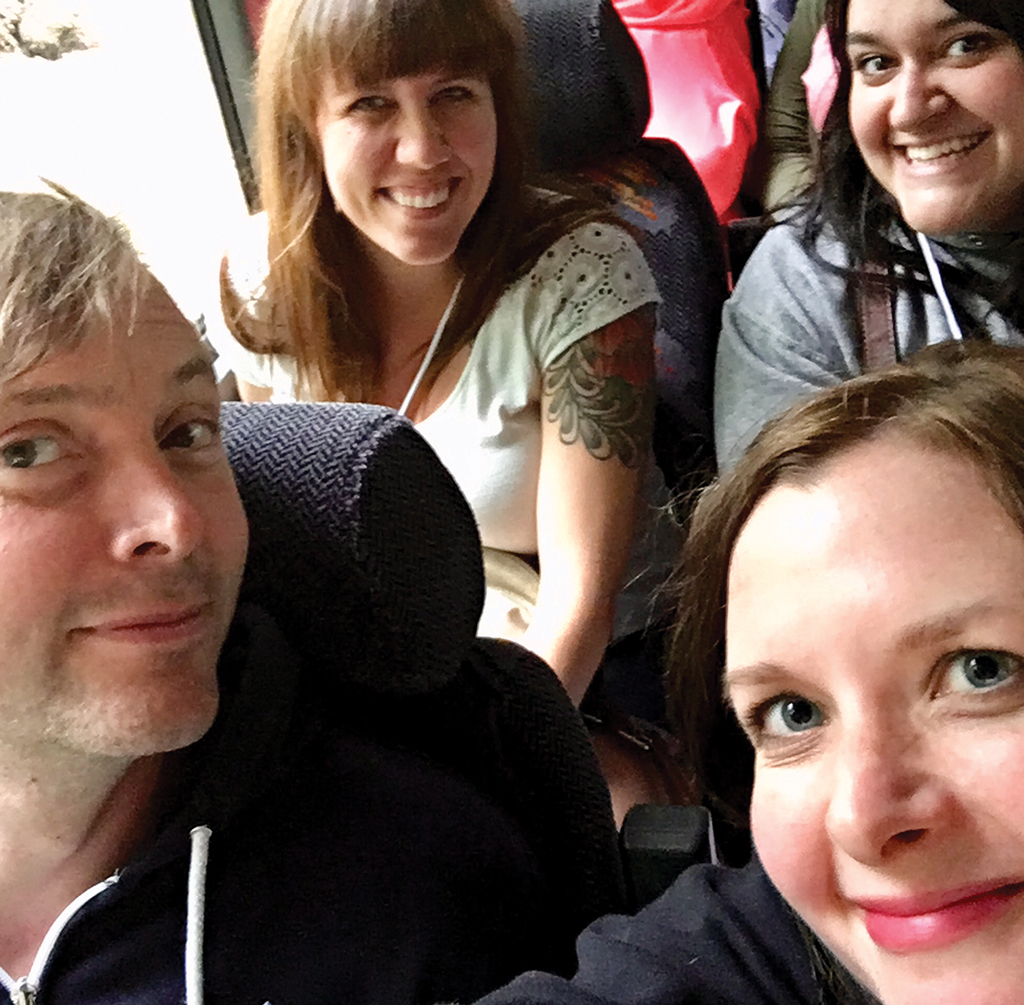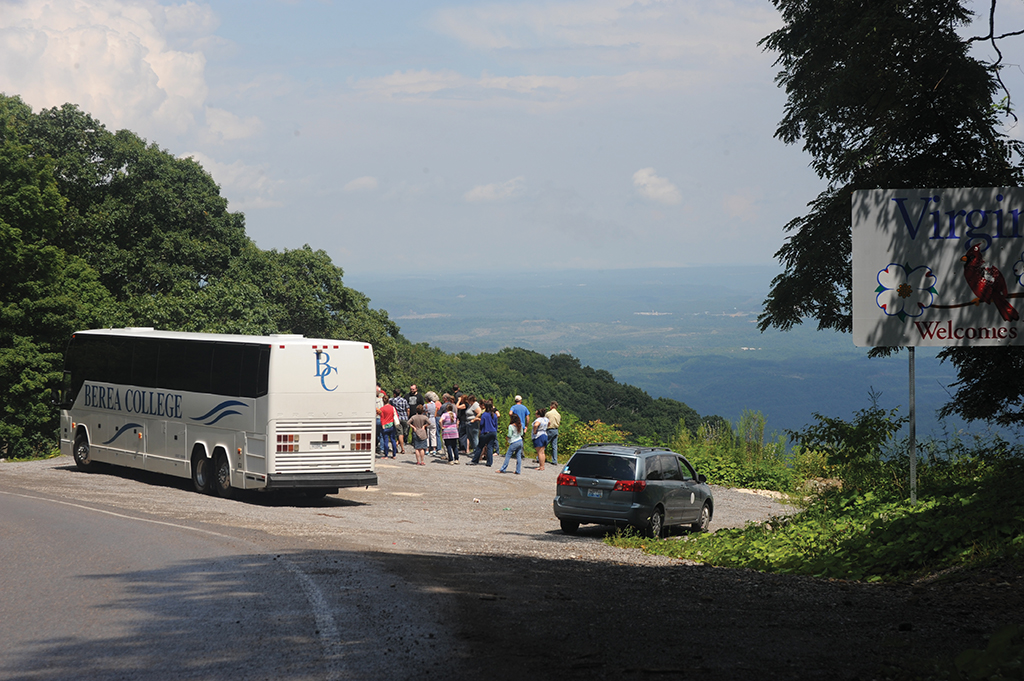Every other summer, the blue and white Berea College bus winds its way over a narrow, mountainous road in eastern Kentucky, rock wall to the left, nothing but sky to the right, as the tires edge the cliffs and the passengers hold their breath. Soon, the coach will land along a ridge where riders exit, look out over Virginia, and understand that once upon a time you could see mountaintops from here. A man will meet them against the backdrop of a scarred landscape and tell them about the legacy of coal and mountaintop removal.
The group has just left Lynch, Ky., an old coal camp where they met with miners and heard their stories in the pews of the local church. From here they will descend to Big Stone Gap for the night and take in the local theater. And they will be tired. Yesterday was the Cowan Creek Community Center and the Pine Mountain Settlement School, where they learned country dancing. Tomorrow is Knoxville for an exploration of urban Appalachia and, after four days on the road, the tourists will return to Berea, exhausted and myth-busted.

This is a journey known as the Appalachian Tour, a rite of passage for new staff and faculty at Berea College dating back to at least the 1950s. The general idea is that if you are coming to work at Berea, you will need to know where many of your students are coming from.
As director of the Loyal Jones Appalachian Center, Dr. Chris Green leads this biennial event. He doesn’t plan the trip—he “choreographs” it.
“I have to choreograph that by connections [to people],” he said. “I have to choreograph it by path, meaning where do we go earlier? Where do we go later? How do we make a circle of it?”
He also does a demographic analysis of where Berea College students are from in Appalachia and choreographs the tour to try to reach these places.
“There are many different Appalachias,” Green said, referring to the diverse communities that exist within the 1,500-mile mountain range that is home to 28 million Americans across 13 states. Berea’s Appalachian Tour focuses more locally, the central Appalachian region that includes eastern Kentucky, southern West Virginia, western Virginia and east Tennessee. Even within this more limited slice of the mountains there are diverse populations to encounter and diverse landscapes that are rural, urban and industrial.
The tour begins in Berea with a full-day seminar on the region that includes Appalachian speakers and literature. In the past this has included Appalachian writers like Kentucky Poet Laureate Crystal Wilkinson and novelist Silas House, with literature and lectures from both. In addition to the literary, the readings include topics like heritage, stereotypes, language and identity, and policies that affected the region.

It takes Green about six months to choreograph a triumph of logistical planning that covers four days on the road with every minute accounted for, the bus reserved, the people contacted and scheduled and the stops coinciding with events that are taking place. This is possible because of the willingness of the local experts to help—that in itself is a measure of their respect for Berea College’s enduring connection to the region, President Lyle Roelofs said.
“It’s a beautiful job to find a way to help people have an immersive experience,” Green said. “They get to go to new places, have an adventure, have fun, learn a lot and bond.”
Green notes that people who work in higher education tend to be travelers. They take their expertise to places around the nation and world, but they may not have much familiarity with where they end up.
“Berea is a little bit different,” he said, “because staff and faculty choose to come to Berea for the opportunity but also the mission, which means they feel called to it.”
But the fact remains that even people from the region may not have as much familiarity with the area as one might expect.

“Coming from the region, I don’t think I’ve ever called myself Appalachian until I was taught that was the word for being from that area,” said Maggie Smith ’16. “It’s just not something you talked about in high school. We just thought we were country.”
Smith helped organize the tour as a student in 2014, while working at the Appalachian Center. She also was the lone student permitted to attend that year.
“The fact that Berea has a line item in their budget for people to go and learn firsthand about the region is really special,” Smith said. “We can see images on a piece of paper, or on our screens, but until you’re actually walking on the ground and experiencing people, one-to-one, in person, there’s a different feeling about that. There’s something about it that really sticks with you.”
Experiencing the place in person changes people. Dr. Dee Hill-Zuganelli went on the tour just as he arrived in Berea in 2016, before assuming his duties as assistant professor of Family Studies. Though Hill-Zuganelli is originally from nearby Elizabethtown and spent a significant amount of time in Lexington, he knew very little about the region Berea College served.

“My experience of Appalachia was really limited to what I heard on the news and about problems affecting the communities there,” he said. “What changed me was that I met people and learned about how important it is to resist narratives like that. People living in Appalachia have to contend with the changing landscape around the coal economy, they do have to contend with mountaintop removal, and some communities are ravaged by opioid use. But I had to quit defining Appalachian people by those problems. You can’t really appreciate what life is really like in Appalachia unless you actually get in it and see it and talk to people.”
Melissa Strobel, director of Foundation Relations and Family Philanthropy, attended the same tour as Hill-Zuganelli. She came from New England in 2015 and admits she knew very little about Kentucky or the Appalachian region before moving to Berea.
“Understanding Appalachia feels like a prerequisite for doing your job well,” she said. But “Appalachia wasn’t something we learned about in school in Massachusetts.”
She recounts that one stop along the way was at a man’s front yard. The group disembarked from the bus there to listen to his story of losing his land to the building of a prison.
“It wasn’t an outsider’s tour,” said Strobel. “It was an insider’s tour. That’s something I think only Berea could deliver. You can’t do that on your own.”
The idea that it’s an insider’s tour that is a prerequisite for doing your job well is echoed in the sentiments of Dr. Valeria Watkins, student support advisor for the Black Music Ensemble. As an advisor, Watkins says the experience of gaining knowledge about Appalachia has helped her in relation to Appalachian students who might be reluctant to open up.
“There’s something about the Appalachian South where you just don’t air dirty laundry in front of other people, especially someone that’s not the same race as you,” Watkins said. “So I found that I could talk about Appalachia in my experience and assist students in feeling comfortable, that I was not judging how they were raised but that I was here to help them process it. We start working on tough issues…abuse, poverty, racial bias, integrity. [The Appalachian Tour] had a profound impact on my work with all students, even those students who are not from Appalachia.”
You need to know where at least most of our students come from,” he said. “You’ve got to go to the places because if you don’t, all you really have is some pretty restricted narratives about what you hear about Appalachia.
Dr. Dee Hill-Zuganelli, CFS
As a teacher, Dr. Hill-Zuganelli relates that the tour helped dispel common myths about the region, especially when it comes to its racial and cultural diversity. This has helped him relate to his students.
“You need to know where at least most of our students come from,” he said. “You’ve got to go to the places because if you don’t, all you really have is some pretty restricted narratives about what you hear about Appalachia. The reality is, our kids, when they come here, can tell you, one, it’s not like that, and then two, that they recognize the limits of where they grew up. When you get to know students from the region, you get a sense of what they’re bringing and the importance of getting this education that for a lot of Appalachians is not accessible.”
Each of these tour attendees used the same phrase to describe it: “eye-opening.” They learned about the realities, the myths, the struggle, and the successes in ways they had not anticipated. Abstract impressions from a distance were replaced by connections to real people and their stories and situations. And for each, the Appalachian Tour was essential for understanding the mission of Berea College and their roles within it.
“I want to help our staff and faculty to see they are working with a community,” Dr. Green said. “We are partners with people in the region, and we have
a lot to learn. At the same time, I get to have these joyful connections with people. It’s always about the joy underneath it, too.”



I didn’t know about this tradition at Berea, but I love it. It’s another thread added to the tapestry representing my life through the countless connections to my beloved institution.